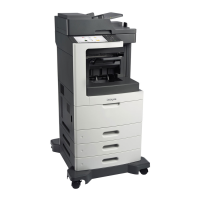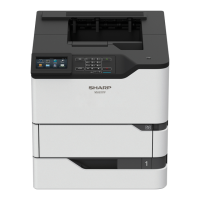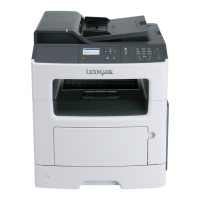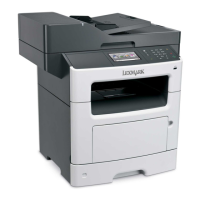Do you have a question about the Lexmark MX61 SERIES and is the answer not in the manual?
Accessing diagnostic procedures for troubleshooting.
Procedures for keeping the printer in optimal working condition.
Important safety information and legal notices regarding product use.
List of registered trademarks associated with the product.
Alphabetical listing of topics and page numbers for quick reference.
Details on the Class I laser product certification and internal laser classification.
General safety guidelines, warnings, and precautions for product handling.
Explains notes, warnings, and cautions used throughout the service manual.
Lists revisions and updates made to the manual with dates.
Guidance on printing with specialty media.
Recommendations for selecting and using various paper types.
Details on paper properties affecting print quality and reliability.
Guidelines for choosing and using appropriate paper types.
Guidelines for selecting preprinted forms and letterhead.
Recommendations for proper paper storage to avoid jams and quality issues.
Information on using recycled paper and Lexmark's testing.
Tips for using card stock, envelopes, and labels.
Tables detailing supported paper sizes, types, and weight capabilities.
Information on the printer's memory types and data storage.
Lists essential tools needed for performing maintenance and repairs.
An overview of the diagnostic approach and key troubleshooting sections.
Essential preliminary steps before starting detailed troubleshooting procedures.
Procedures for diagnosing and resolving common print quality problems.
Information on understanding and clearing various types of paper jams.
Explanations of common printer messages and required actions.
Information on messages requiring user interaction or attention.
Error codes and troubleshooting steps for printer hardware failures.
Error codes and troubleshooting steps specific to ADF and scanner hardware.
Error codes and troubleshooting for hardware issues related to I/O options.
Troubleshooting steps for various general printer symptoms.
Essential safety precautions before performing part removal.
Procedures for erasing sensitive data from printer memory.
Guidelines for safely handling parts sensitive to electrostatic discharge.
Procedures for replacing the controller board and control panel.
Steps to restore printer configuration using the Service Restore Tool.
Diagrams illustrating the location of external printer components.
Illustration of the printer's front view with numbered components.
Identification of basic components on the front view.
Illustration of the printer with optional trays and stapler.
Diagram showing external connections and ports on the rear of the printer.
Diagrams and lists of connectors on the controller board.
Schematic diagram of the controller board and its connectors.
Table detailing inspection intervals for printer parts.
Information on scheduled maintenance procedures and kits.
Lists of available maintenance kits and their contents.
Steps to reset the printer's maintenance counter after kit replacement.
Guidelines for lubricating printer parts and specifying lubricant types.
Procedures for cleaning the printer's exterior and interior.
Instructions for cleaning the scanner glass to improve image quality.
Explanation of abbreviations and column headings used in the parts catalog.
Exploded view and parts list for printer covers.
Exploded view and parts list for imaging components like ADF and scanner.
Exploded view and parts list for the printer's control panel assembly.
Exploded view and parts list for electronic components, including fuser and controller board.
Exploded view and parts list for additional electronic components and sensors.
Exploded view and parts list for the printer's internal frame and drive mechanisms.
Exploded view and parts list for optional paper trays.
Exploded view and parts list for the staple finisher option.
Exploded view and parts list for the right side of the staple finisher.
Exploded view and parts list for the top section of the staple finisher.
Exploded view and parts list for the rear section of the staple finisher.
Exploded view and parts list for the staple finisher's exit assembly.
Exploded view and parts list for the staple finisher's tamper assembly.
Exploded view and parts list for the staple finisher's accumulator assembly.
List of available maintenance kits for the printer.
List of available power cords for different regions.
List of miscellaneous parts such as adapters, font cards, and memory.
Details on low-voltage and high-voltage AC power requirements.
Recommended space around the printer for proper operation and ventilation.
Sound pressure and power level measurements conforming to ISO standards.
Technical details of the scanner, including imaging technology and resolution.
Specifies the maximum number of sheets the ADF can hold.
Technical details of the printer's fax capabilities, including modem speed and memory.
Lists internal options such as memory cards and fonts.
Details on available memory card types like Flash memory and Fonts.
Lists available media handling options such as paper trays and feeders.
Describes the Power-On Reset sequence and hardware integrity checks.
Explains the processor roles in RIP and engine functions.
Details component functions for feeding media from trays.
Explains the function of sensors and motors in the input tray feeding process.
Describes the operation of the MPF, including paper sensing and feeding mechanisms.
Explains the paper path and toner transfer process in simplex printing.
Describes the process of printing on both sides of the media.
Explains the function of key mechanical components in media transport.
Detailed explanation of the EP process steps: Charge, Expose, Develop, Transfer, Clean.
Explains the theory of operation and cross-section of the ADF.
Explains the path media takes through the duplex ADF during scanning.
A list of acronyms used in the manual and their meanings.
Special symbols used in the manual.
Accessing diagnostic procedures for troubleshooting.
Procedures for keeping the printer in optimal working condition.
Important safety information and legal notices regarding product use.
List of registered trademarks associated with the product.
Alphabetical listing of topics and page numbers for quick reference.
Details on the Class I laser product certification and internal laser classification.
General safety guidelines, warnings, and precautions for product handling.
Explains notes, warnings, and cautions used throughout the service manual.
Lists revisions and updates made to the manual with dates.
Guidance on printing with specialty media.
Recommendations for selecting and using various paper types.
Details on paper properties affecting print quality and reliability.
Guidelines for choosing and using appropriate paper types.
Guidelines for selecting preprinted forms and letterhead.
Recommendations for proper paper storage to avoid jams and quality issues.
Information on using recycled paper and Lexmark's testing.
Tips for using card stock, envelopes, and labels.
Tables detailing supported paper sizes, types, and weight capabilities.
Information on the printer's memory types and data storage.
Lists essential tools needed for performing maintenance and repairs.
An overview of the diagnostic approach and key troubleshooting sections.
Essential preliminary steps before starting detailed troubleshooting procedures.
Procedures for diagnosing and resolving common print quality problems.
Information on understanding and clearing various types of paper jams.
Explanations of common printer messages and required actions.
Information on messages requiring user interaction or attention.
Error codes and troubleshooting steps for printer hardware failures.
Error codes and troubleshooting steps specific to ADF and scanner hardware.
Error codes and troubleshooting for hardware issues related to I/O options.
Troubleshooting steps for various general printer symptoms.
Essential safety precautions before performing part removal.
Procedures for erasing sensitive data from printer memory.
Guidelines for safely handling parts sensitive to electrostatic discharge.
Procedures for replacing the controller board and control panel.
Steps to restore printer configuration using the Service Restore Tool.
Diagrams illustrating the location of external printer components.
Illustration of the printer's front view with numbered components.
Identification of basic components on the front view.
Illustration of the printer with optional trays and stapler.
Diagram showing external connections and ports on the rear of the printer.
Diagrams and lists of connectors on the controller board.
Schematic diagram of the controller board and its connectors.
Table detailing inspection intervals for printer parts.
Information on scheduled maintenance procedures and kits.
Lists of available maintenance kits and their contents.
Steps to reset the printer's maintenance counter after kit replacement.
Guidelines for lubricating printer parts and specifying lubricant types.
Procedures for cleaning the printer's exterior and interior.
Instructions for cleaning the scanner glass to improve image quality.
Explanation of abbreviations and column headings used in the parts catalog.
Exploded view and parts list for printer covers.
Exploded view and parts list for imaging components like ADF and scanner.
Exploded view and parts list for the printer's control panel assembly.
Exploded view and parts list for electronic components, including fuser and controller board.
Exploded view and parts list for additional electronic components and sensors.
Exploded view and parts list for the printer's internal frame and drive mechanisms.
Exploded view and parts list for optional paper trays.
Exploded view and parts list for the staple finisher option.
Exploded view and parts list for the right side of the staple finisher.
Exploded view and parts list for the top section of the staple finisher.
Exploded view and parts list for the rear section of the staple finisher.
Exploded view and parts list for the staple finisher's exit assembly.
Exploded view and parts list for the staple finisher's tamper assembly.
Exploded view and parts list for the staple finisher's accumulator assembly.
List of available maintenance kits for the printer.
List of available power cords for different regions.
List of miscellaneous parts such as adapters, font cards, and memory.
Details on low-voltage and high-voltage AC power requirements.
Recommended space around the printer for proper operation and ventilation.
Sound pressure and power level measurements conforming to ISO standards.
Technical details of the scanner, including imaging technology and resolution.
Specifies the maximum number of sheets the ADF can hold.
Technical details of the printer's fax capabilities, including modem speed and memory.
Lists internal options such as memory cards and fonts.
Details on available memory card types like Flash memory and Fonts.
Lists available media handling options such as paper trays and feeders.
Describes the Power-On Reset sequence and hardware integrity checks.
Explains the processor roles in RIP and engine functions.
Details component functions for feeding media from trays.
Explains the function of sensors and motors in the input tray feeding process.
Describes the operation of the MPF, including paper sensing and feeding mechanisms.
Explains the paper path and toner transfer process in simplex printing.
Describes the process of printing on both sides of the media.
Explains the function of key mechanical components in media transport.
Detailed explanation of the EP process steps: Charge, Expose, Develop, Transfer, Clean.
Explains the theory of operation and cross-section of the ADF.
Explains the path media takes through the duplex ADF during scanning.
A list of acronyms used in the manual and their meanings.
Special symbols used in the manual.
| Print Technology | Laser |
|---|---|
| Functions | Copy, Fax, Print, Scan |
| Recommended Monthly Page Volume | 2, 000 to 15, 000 pages |
| Duplex Printing | Standard |
| Connectivity | Ethernet |
| Maximum Paper Size | 8.5 x 14 inches |
| Operating System Compatibility | Linux, Windows |











